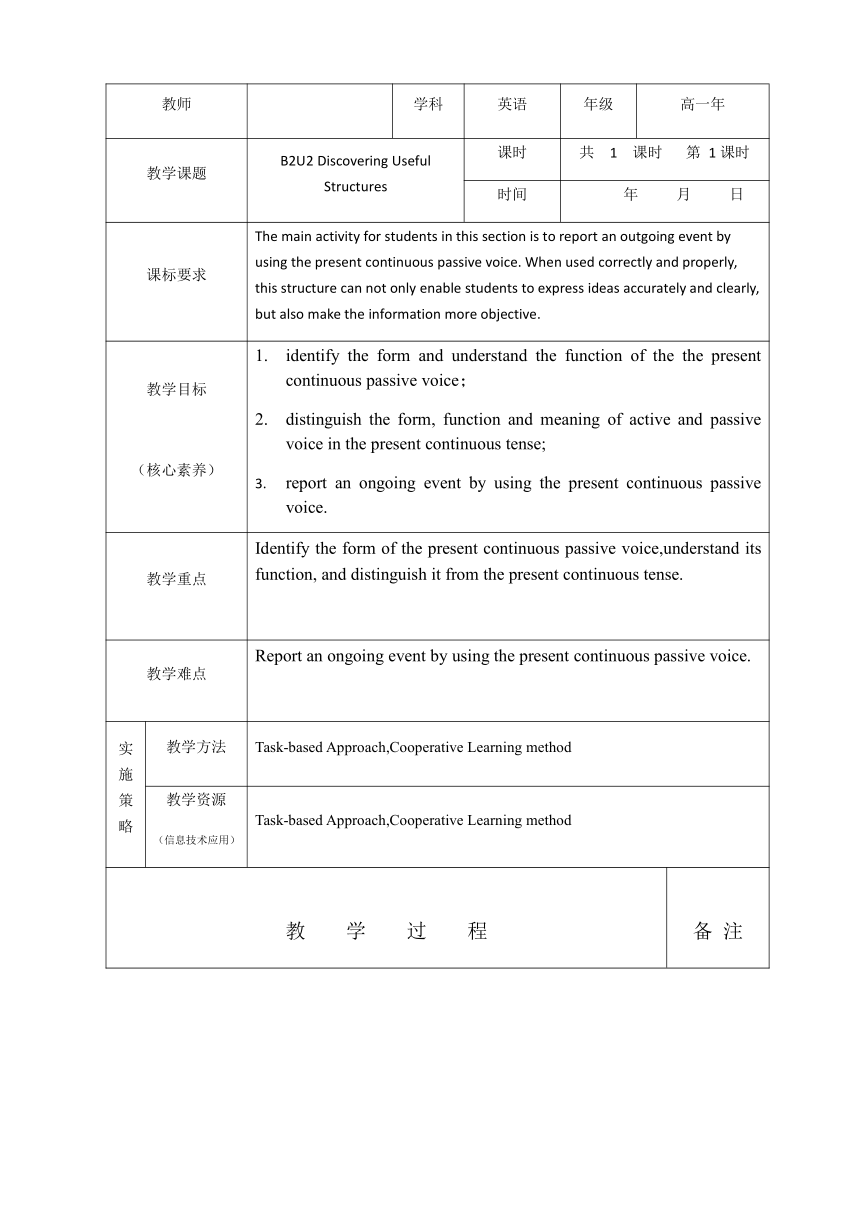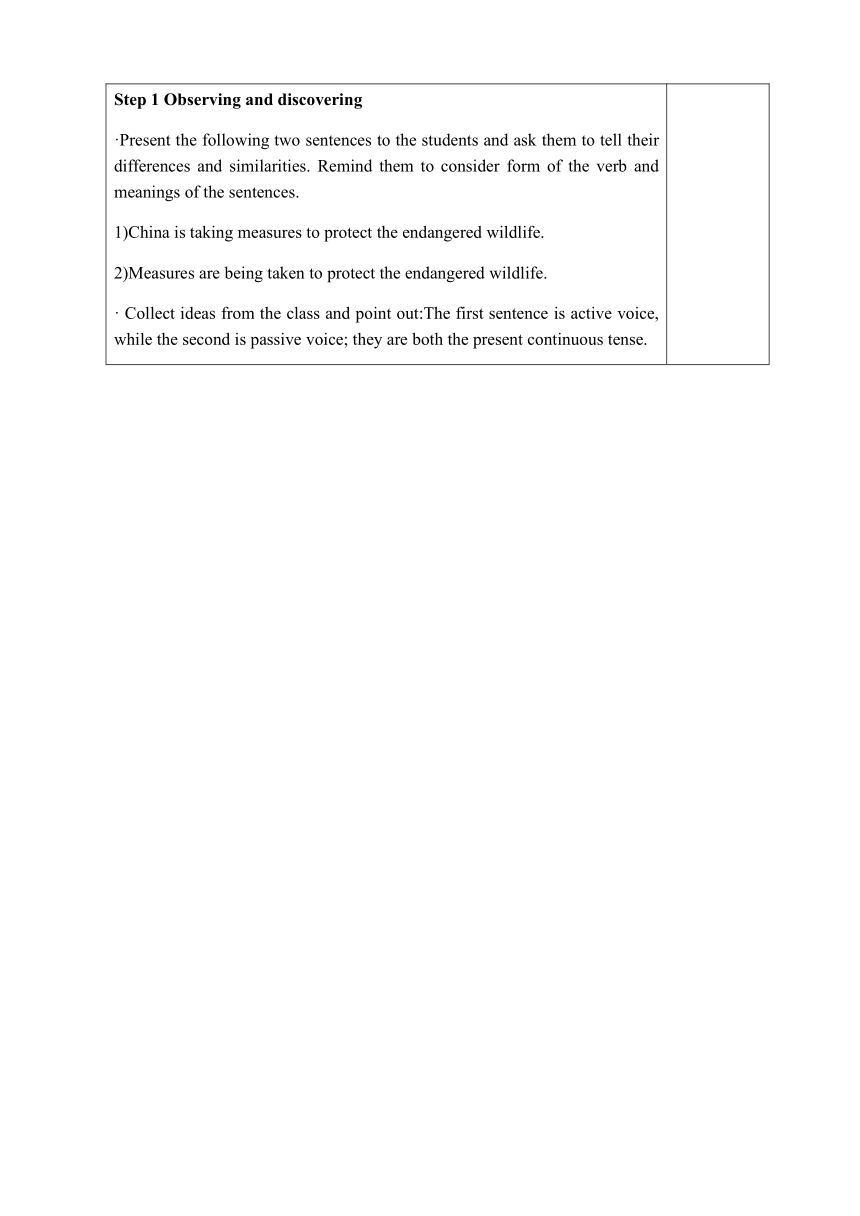人教版(2019)必修第二册 Unit2 Wildlife protection Discovering Useful Structure教案(表格式)
文档属性
| 名称 | 人教版(2019)必修第二册 Unit2 Wildlife protection Discovering Useful Structure教案(表格式) |  | |
| 格式 | docx | ||
| 文件大小 | 33.1KB | ||
| 资源类型 | 教案 | ||
| 版本资源 | 人教版(2019) | ||
| 科目 | 英语 | ||
| 更新时间 | 2022-04-15 00:01:00 | ||
图片预览


文档简介
教师 学科 英语 年级 高一年
教学课题 B2U2 Discovering Useful Structures 课时 共 1 课时 第 1课时
时间 年 月 日
课标要求 The main activity for students in this section is to report an outgoing event by using the present continuous passive voice. When used correctly and properly, this structure can not only enable students to express ideas accurately and clearly, but also make the information more objective.
教学目标 (核心素养) identify the form and understand the function of the the present continuous passive voice; distinguish the form, function and meaning of active and passive voice in the present continuous tense; report an ongoing event by using the present continuous passive voice.
教学重点 Identify the form of the present continuous passive voice,understand its function, and distinguish it from the present continuous tense.
教学难点 Report an ongoing event by using the present continuous passive voice.
实施策略 教学方法 Task-based Approach,Cooperative Learning method
教学资源 (信息技术应用) Task-based Approach,Cooperative Learning method
教 学 过 程 备 注
Step 1 Observing and discovering ·Present the following two sentences to the students and ask them to tell their differences and similarities. Remind them to consider form of the verb and meanings of the sentences. 1)China is taking measures to protect the endangered wildlife. 2)Measures are being taken to protect the endangered wildlife. · Collect ideas from the class and point out:The first sentence is active voice, while the second is passive voice; they are both the present continuous tense.
·Ask students to underline the same form of the verb in the sentences in Activity 1 on page 18 as the second sentence shown on the screen. · Pair students to check their answers with each other. Offer help if necessary. Step 2 Enhancing understanding 1.Analyzing · Ask students to read about the passive voice on page 98 and write down the forms of the present continuous passive voice. · Pair students to find more sentences with the present continuous passive voice in the reading text and discuss its function. · Check the sentences and let students present their understandings of the function of the present continuous passive voice. 2.Discussing and comparing · Ask students to choose the suitable verb forms to complete the sentences in Activity 2 on page 18. · Collect the answers from the class and provide help if necessary. · Group students to read the first and fifth sentences in Activity 2 on page 18, compare the verb forms and discuss their functions. · Collect ideas from groups. · Conclude the differences and similarities of the form and function of active voice and passive voice in the present continuous tense. Step 3 Practicing ·Ask students to read the passage in Activity 3 on page 18 and fill in the blanks. ·Invite some students to show their answers and explain the function of the verbs. ·Pair students to list endangered animals and plants in the neighborhood and think about their suffering. ·Group students to determine one endangered animal or plant, and then discuss how to protect it. Remind them of the verb forms. (Activity 4 on page 18) ·Invite some students to give a presentation of the ideas of their Make comments if necessary. Blackboard Design U2S3 Discovering Useful Structures The form of the present continuous passive voice Passive voice: be done The present continuous tense:am/is/are doing The present continuous passive voice: Subject+am/is/are being done... Am/Is/Are+Subject+being done ... The present continuous tenseFormFunctionActive voiceSubject+am/is/are doing...主动关系 是主动关xi系(主谓关系)Subject+am/is/are not doing...Am/is/are+Subject+doing... Passive voiceSubject+am/is/are being done...被动关系Subject+am/is/are not being done...Am/Is/Are+Subject+being done...
differences between active voice and passive voice in the present continuous tense
作 业 (体现分层设计) Ask students to finish the exercise on page 68&69.
教 学 反 思 成 效
困 惑
教学课题 B2U2 Discovering Useful Structures 课时 共 1 课时 第 1课时
时间 年 月 日
课标要求 The main activity for students in this section is to report an outgoing event by using the present continuous passive voice. When used correctly and properly, this structure can not only enable students to express ideas accurately and clearly, but also make the information more objective.
教学目标 (核心素养) identify the form and understand the function of the the present continuous passive voice; distinguish the form, function and meaning of active and passive voice in the present continuous tense; report an ongoing event by using the present continuous passive voice.
教学重点 Identify the form of the present continuous passive voice,understand its function, and distinguish it from the present continuous tense.
教学难点 Report an ongoing event by using the present continuous passive voice.
实施策略 教学方法 Task-based Approach,Cooperative Learning method
教学资源 (信息技术应用) Task-based Approach,Cooperative Learning method
教 学 过 程 备 注
Step 1 Observing and discovering ·Present the following two sentences to the students and ask them to tell their differences and similarities. Remind them to consider form of the verb and meanings of the sentences. 1)China is taking measures to protect the endangered wildlife. 2)Measures are being taken to protect the endangered wildlife. · Collect ideas from the class and point out:The first sentence is active voice, while the second is passive voice; they are both the present continuous tense.
·Ask students to underline the same form of the verb in the sentences in Activity 1 on page 18 as the second sentence shown on the screen. · Pair students to check their answers with each other. Offer help if necessary. Step 2 Enhancing understanding 1.Analyzing · Ask students to read about the passive voice on page 98 and write down the forms of the present continuous passive voice. · Pair students to find more sentences with the present continuous passive voice in the reading text and discuss its function. · Check the sentences and let students present their understandings of the function of the present continuous passive voice. 2.Discussing and comparing · Ask students to choose the suitable verb forms to complete the sentences in Activity 2 on page 18. · Collect the answers from the class and provide help if necessary. · Group students to read the first and fifth sentences in Activity 2 on page 18, compare the verb forms and discuss their functions. · Collect ideas from groups. · Conclude the differences and similarities of the form and function of active voice and passive voice in the present continuous tense. Step 3 Practicing ·Ask students to read the passage in Activity 3 on page 18 and fill in the blanks. ·Invite some students to show their answers and explain the function of the verbs. ·Pair students to list endangered animals and plants in the neighborhood and think about their suffering. ·Group students to determine one endangered animal or plant, and then discuss how to protect it. Remind them of the verb forms. (Activity 4 on page 18) ·Invite some students to give a presentation of the ideas of their Make comments if necessary. Blackboard Design U2S3 Discovering Useful Structures The form of the present continuous passive voice Passive voice: be done The present continuous tense:am/is/are doing The present continuous passive voice: Subject+am/is/are being done... Am/Is/Are+Subject+being done ... The present continuous tenseFormFunctionActive voiceSubject+am/is/are doing...主动关系 是主动关xi系(主谓关系)Subject+am/is/are not doing...Am/is/are+Subject+doing... Passive voiceSubject+am/is/are being done...被动关系Subject+am/is/are not being done...Am/Is/Are+Subject+being done...
differences between active voice and passive voice in the present continuous tense
作 业 (体现分层设计) Ask students to finish the exercise on page 68&69.
教 学 反 思 成 效
困 惑
